Discover the Design - What Makes Discover Such a Good Hearthstone Mechanic?
Game Design - 25 Mar 2020
I often look back on released Hearthstone mechanics in order to improve my own designs, especially since I will be returning to the initial design team this summer for a second internship. There are many successes (and a handful of failures) that I've taken lessons from, but Discover stands out to me as perhaps the best-designed mechanic in Hearthstone. In the game, Discover reads "Choose one of three cards to add to your hand." Below, I've included several examples of how it is used on a card.
Every time I come back to it as an example to learn from, I recognize a new way in which Discover makes Hearthstone a better game. I think this is because of how elegant its design is. Jesse Schell finds that the elegance of a game element can be measured by the number of purposes that it serves. So in an effort to better understand what makes Discover such a good mechanic, I've decided to list all of the purposes that it serves in Hearthstone.

Deliver Theme and Flavor
Discover made its first appearance in (and was designed especially for) the League of Explorers, a Hearthstone expansion in which a team of explorers set out to "Explore Azeroth's most mysterious archaeological sites and discover ancient treasures." The wording here is not a coincidence. The Discover mechanic parallels the story of the League of Explorers by allowing you as the player to (quite literally) explore and discover cards during the game. Arch-Thief Rafaam, the villain of the League of Explorers, is a prime example of how Discover can bring out the flavor of this story. He wants to steal a powerful artifact (one of several), which is exactly what you get to do when you play his card. By choosing which one he steals, you are engaged directly in the storytelling.
Give Players Agency
Because randomness is so core to Hearthstone, players can sometimes feel cheated or unlucky. Discover (usually) involves randomness, but combats this issue with an emphasis on player agency: you get to choose the card you take. To see how important this is, observe that deck-building is the primary avenue of agency when it comes to card selection. The class that you play and the cards in your deck are entirely up to you, but those decisions are over before the game even begins. With Discover, you continue to make decisions about what cards you play with during the game. Whether the player is trying to express themself or prove their skills, reinforcing their feeling of agency is powerful.
Inspire the Player's Imagination
With literally thousands of cards in the game, there will often be a great variety of possible cards to Discover. Before a player uses their Discover card, they will think to themselves, "What could I get?" And that's where the magic happens. Even before any cards are presented to them, they come up with all kinds of possible outcomes, and get excited about what they could do with those results. Before playing Drakonid Operative, you might think of 30 different cards in your opponent's deck. If even one of them gets you excited, then Discover has succeeded at inspiring your imagination.
Generate Stories
Hearthstone prides itself in creating wild, unexpected scenarios through interactions and random effects. When we can pull that off, you'll run to your friends to tell them all about the coolest, craziest thing you did in your last match! Discover is a perfect example of a mechanic that enables these types of player stories. The wide array of possibilities (Inspire the Player's Imagination) combined with the feeling of agency when selecting from among your options (Give Players Agency) is a recipe for memorable and personal gameplay narratives.


Utilize the Design Space
Hearthstone has a variety of core game elements: Cards in your hand or deck, minions on the board, the heroes themselves, your hero power... This is just a handful of the game elements that are present. And Discover can interact with every single of these. Finding a new fundamental way for players to interact with your core game elements is powerful, and can reinforce each of those elements independently. Archivist Elysiana illustrates this by twisting the standard Discover effect (adding a card to your hand) to instead replace the cards in your deck. The way players think about their deck when Elysiana is available has been turned on its head.
Diversify the Design Space
Discover also opens up the design space for future mechanics. Any new keyword, theme, cycle, class... they can all use Discover in a different way. In addition, many possibilities are opened up by Discover that couldn't have been done before. Thus, it is no surprise to me that every expansion has included Discover cards since it debuted in the League of Explorers.
Expose the Hearthstone Universe
Hundreds of new cards are created and released every few months, but a large percentage of them see minimal play in modes where players construct their own decks. Discover can bring these rarely-seen cards into the game, allowing players to see a larger variety of characters, themes, and mechanics than they would have otherwise. This wider exposure also makes each expansion feel more cohesive. The Runespear, a Shaman weapon, made it so that every Shaman spell would come around in one game or another.
Utilize Technology & Platform
Hearthstone is an exclusively digital game in a genre defined by the physical objects that you interact with: cards. There are limitations that come with this choice of platform, but it also means that certain mechanics may be possible that can't be done in physical counterparts such as Magic: The Gathering. Discover is an excellent example of how Hearthstone is able to utilize its digital environment. When 3 cards are randomly selected from a pool of hundreds, a physical cardgame would require you to have all those cards prepared in a side-deck ahead of time. Thus, Discover brings a new type of gameplay to this genre which would not have been developed for a physical cardgame.


Reward Game Knowledge
Competitiveness in Hearthstone is a delicate balance, because randomness will always be involved. Rewarding skilled players is a great way to support competitiveness. One way that Discover does this is by rewarding players who have better knowledge of the cards that are available in a certain Discover pool. With a clear idea of what options could be presented before using Discover at all, a skilled player can evaluate their options critically. With Madame Lazul, you can use all knowledge of your opponent's class, deck, and current hand to decide whether or not it is a good turn to Discover a copy of a card in their hand.
Reward Foresight
Discover also allows more skilled players to exercise their high-level strategies and ability to plan ahead. If a player can foresee their goals several turns in advance, or predict what their opponent will do, then they can choose the Discover option that is strongest in the long run. A carefully considered choice may take the whole game to pay off. In the Grand Finals of Masters Tour Los Angeles 2020, XBlyzes chose Malygos's Fireball from Zephrys, and used it many turns later for perfect lethal against TNCAnswer to close out the tournament.
Empower the Player with Good UI
It is important to have a user interface that is intuitive and makes the player feel like they are in control of their interactions. When the three Discover options are presented to you, most of the board is obstructed. But you almost certainly want to look at the board to decide what you should pick! One solution would have been to present the options in a smaller spot, out of the way. Hearthstone instead chose to give you the power of showing or hiding the cards. You get to see them big and up front while you're reading and considering your options, but can tuck them away when you want to focus on the board.
Accentuate Game Feel
Hearthstone prides itself in being juicy and tactile (if a digital game can be called that). Objects in the gamespace are often interactable, including the board itself. You can click on them and get all kinds of satisfying audiovisual feedback. Discover accentuates this by giving you a satisfying splash of gold coins (and corresponding jingle of treasure) every time you click the hide/show button. If nothing else, playing a Discover card just feels good.

Closing Thoughts
If you've played Hearthstone at all yourself, I hope that you now have a greater appreciation for the elegance of Discover. If not, I hope I didn't lose you along the way. I found 12 different purposes that Discover serves in Hearthstone, but I would not be surprised if I return to this piece one day to add more. And in an effort to continue improving Hearthstone, I aim to one day design a mechanic which serves as many purposes as Discover.
Questions I'm Still Left Wondering
Is there any other Hearthstone mechanic, past or future, that serves this many purposes?
Does Discover have design flaws as well?
What was the design process behind Discover? Was it top-down, or bottom-up? Were there earlier iterations that functioned differently?